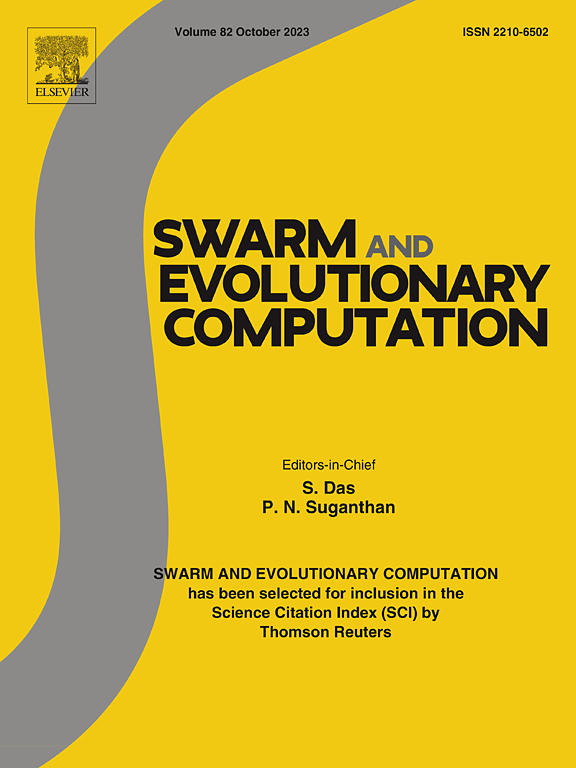Heuristic-guided scatter search for X-architecture Steiner Minimum Tree problems in VLSI design
IF 8.5
1区 计算机科学
Q1 COMPUTER SCIENCE, ARTIFICIAL INTELLIGENCE
引用次数: 0
Abstract
Constructing Steiner Minimum Trees (SMT) remains a critical challenge in Very Large Scale Integration (VLSI) global routing, where minimizing wirelength is essential for optimizing circuit performance. While traditional Manhattan-based SMTs are constrained to two orthogonal routing directions, resulting in suboptimal interconnects, the X architecture, with its eight-directional (four rectilinear, four diagonal) routing, enables significant wirelength reductions. This paper introduces a Heuristic-Guided Scatter Search (HGSS) algorithm to efficiently solve the X-architecture SMT (XSMT) problem. The HGSS integrates a short-edge-first heuristic to prioritize compact routing solutions and reengineers three core Scatter Search modules: (1) a Dynamic Reference Set Update Module (DRSUM) that maintains elite and diverse solutions through iterative replacement, (2) a Semi-systematic Subset Generation Module (SSGM) pairing diverse and random elite solutions to reduce computational overhead, and (3) a Heuristic-Guided Solution Combination Module (HGSCM) employing crossover and mutation to generate high-quality offspring. Evaluations of GEO and ISPD98 benchmark circuits demonstrate average wirelength reductions of 1.04% and 2.86%, respectively, along with superior computational efficiency compared to state-of-the-art methods. By advancing XSMT optimization, this work demonstrates that incorporating heuristic information is valuable for solving large, complex routing tree problems, offering guidance for further research in this area.
超大规模集成电路设计中x结构Steiner最小树问题的启发式引导散射搜索
构建Steiner最小树(SMT)仍然是超大规模集成电路(VLSI)全局路由中的一个关键挑战,其中最小化无线对于优化电路性能至关重要。传统的基于曼哈顿的smt受限于两个正交的路由方向,导致互连不理想,而X架构具有8个方向(4个直线,4个对角线)路由,可以显着减少无线长度。介绍了一种启发式引导散点搜索(HGSS)算法,以有效地解决X-architecture SMT (XSMT)问题。HGSS集成了一个短边优先的启发式算法来优先考虑紧凑的路由解决方案,并重新设计了三个核心分散搜索模块:(1)动态参考集更新模块(DRSUM)通过迭代替换保持精英解和多样化解;(2)半系统子集生成模块(SSGM)将多样化和随机精英解配对以减少计算开销;(3)启发式引导解组合模块(HGSCM)采用交叉和突变生成高质量后代。GEO和ISPD98基准电路的评估表明,与最先进的方法相比,平均带宽分别减少了1.04%和2.86%,计算效率也更高。通过推进XSMT优化,这项工作证明了结合启发式信息对于解决大型、复杂的路由树问题是有价值的,为该领域的进一步研究提供了指导。
本文章由计算机程序翻译,如有差异,请以英文原文为准。
求助全文
约1分钟内获得全文
求助全文
来源期刊

Swarm and Evolutionary Computation
COMPUTER SCIENCE, ARTIFICIAL INTELLIGENCEC-COMPUTER SCIENCE, THEORY & METHODS
CiteScore
16.00
自引率
12.00%
发文量
169
期刊介绍:
Swarm and Evolutionary Computation is a pioneering peer-reviewed journal focused on the latest research and advancements in nature-inspired intelligent computation using swarm and evolutionary algorithms. It covers theoretical, experimental, and practical aspects of these paradigms and their hybrids, promoting interdisciplinary research. The journal prioritizes the publication of high-quality, original articles that push the boundaries of evolutionary computation and swarm intelligence. Additionally, it welcomes survey papers on current topics and novel applications. Topics of interest include but are not limited to: Genetic Algorithms, and Genetic Programming, Evolution Strategies, and Evolutionary Programming, Differential Evolution, Artificial Immune Systems, Particle Swarms, Ant Colony, Bacterial Foraging, Artificial Bees, Fireflies Algorithm, Harmony Search, Artificial Life, Digital Organisms, Estimation of Distribution Algorithms, Stochastic Diffusion Search, Quantum Computing, Nano Computing, Membrane Computing, Human-centric Computing, Hybridization of Algorithms, Memetic Computing, Autonomic Computing, Self-organizing systems, Combinatorial, Discrete, Binary, Constrained, Multi-objective, Multi-modal, Dynamic, and Large-scale Optimization.
 求助内容:
求助内容: 应助结果提醒方式:
应助结果提醒方式:


